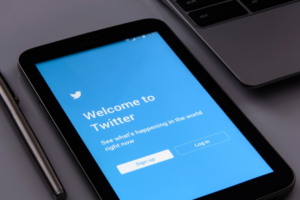Quick! Describe your brand, your services, and your mission— and do it in under 140 characters. That may seem impossible, but on Twitter, you only have 140 characters to share your message. But don’t worry! Even though Twitter messages offer limited space, the marketing possibilities Twitter affords are limitless.
With 100 million daily active users, Twitter is a micro-blog marketplace that boasts endless opportunities to share your brand. To get started, try these 10 quick tips to optimize your presence on Twitter:
1. Put a hashtag on it.
Hashtags are everywhere: Instagram, Facebook, Pinterest— but the originator of the hashtag on social media was Twitter. Hashtags are a means of categorizing content. They’re essentially keywords preceded by a pound sign [#Hashtag]. They serve to expand the reach of your tweets, which is why it’s important to include industry-related and trending hashtags in each post. People searching for specific information— say, cat videos— can browse hashtags related to their search— #cats, #catvideos, #funnycats— to find content that meet their needs. Tweets that include hashtags see twice as many engagements as those with no hashtags, so incorporate one to two hashtags in every tweet.
2. Tweet multiple times per day.
The lifespan of a fresh tweet is approximately 8 minutes. That means one tweet has an 8-minute window to get noticed by followers and anyone searching the hashtags you’ve used. Because Twitter is a such a high-traffic network, you can tweet multiple times per day without overwhelming your audience, and you’ll increase your brand’s opportunity to be seen. A good rule of thumb is to tweet 1 to 5 times per day, and periodically review your analytics to hone in on when you’re getting the most engagements. Adjust your tweeting schedule as necessary to get more attention!
3. Tweet at optimum times.
Every audience is different, so determining your optimum tweet times may require some trial and error. Typically, morning tweets tend to generate the most post clicks, while evening tweets receive the most favorites and retweets. The highest volume of tweeting seems to occur from 11:00am and 1:00pm. Since it’s difficult to pin down exactly when your target audience will be most active and receptive, start by experimenting with a variety of time periods, and fine-tune your schedule when you start hitting the sweet spots.
4. Use images in your posts.
Tweets can only be 140 characters long, which is pretty short by any standards! However, some Twitter users prefer an even more abbreviated form of communication: pictures. Tweets including images are estimated to receive 18% more post clicks and 150% more retweets than posts without images. This does not extend to tweets linked to a Facebook or Instagram account (in fact, these posts get less interaction); for more retweets and clicks, images should be uploaded directly into your tweet. Your character limit is 140, but on Twitter a picture is worth 1,000 words!
5. Use keywords in your Twitter handle and bio.
Implementing keywords into your Twitter handle and bio can help your Google ranking, and get you in front of your target market. Your bio is limited to 160 characters, and your Twitter handle only 15, so you need to choose your words wisely. Be informative, interesting, and brief. Try to get your Twitter handle as close to your company name as possible, or relate it back to your brand in a creative way.
6. Use keywords in your Twitter header and profile images.
Did you know that even the file names of the images you upload can be used as keywords? When adding your profile image and Twitter header (two things your profile should definitely include to complement your brand!) save each JPEG with specific brand-related words. You may not feel the overall results of this tip, but Google will take your file names and recognize them for indexing purposes— so make them count!
7. Use the 20% tweeting balance.
Figuring out what to tweet can be a cumbersome project, especially if you’re new to Twitter and want to put out solid content quickly. According to Michael Clarke, author of the Punk Rock Marketing Collection, one formula you can use to hit major touchstones with your audience is as follows:
-20% of your tweets should be helpful;
-20% of your tweets should be inspirational;
-20% of your tweets should be fun;
-20% of your tweets should be retweets from influencers in your own industry;
-20% of your tweets should be promotional.
Following this formula gives you a framework of what content to tweet, and helps you hit on 5 major areas of interest.
8. Repeat your tweet.
Repeating oneself can be an annoying habit, but on Twitter repetition may help you reach a wider audience. 94 % of tweets are retweeted within the first hour of posting, but not all of your followers are on Twitter at the same time every day. Repeating a tweet— or a variation of it— at different times allows optimum opportunity for it to be seen by your followers and those browsing hashtags. Scheduling platforms like Social Oomph let you easily plan a tweet and then repeat it automatically according to your desired retweeting timeline.
9. Analyze your structure and language.
Twitter is by no means a place where proper grammar and spelling are essential. With only 140 characters available, many grammatical corners are cut trying to squeeze important details into one tweet. However, by analyzing your content, you may find certain words or structures of tweets are receiving more attention than others. Look for patterns in your tweets: Do your shorter posts receive the most clicks? Are posts with certain keywords being retweeted more often? Analyzing what’s working based on your tweet patterns helps you build a model for creating new content.
10. Verify your account.
Verifying your account may not be a move to make right away, but is something to consider as your brand and fan base start to grow. Twitter account verification is a process that confirms your account and company are authentic. With so many users in the Twittersphere, it’s very easy for someone to create an account that impersonates someone else. This is why many celebrities have verified accounts, to prove they are the true authors of their tweets. Trust matters to Twitter users, so if you are a company with a lot of visibility and impact, verifying your account increases the trust factor of your brand and the content you’re sharing on Twitter.
Twitter can seem hard to grasp, mostly because it’s always moving at the speed of light! Using the tips above will get Twitter included as a regular part of your marketing activities, so you can learn what your target audience is searching for and how you can help them find it. #TwitterGameStrong.






